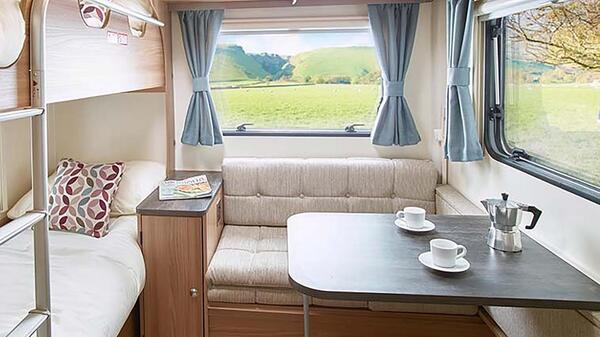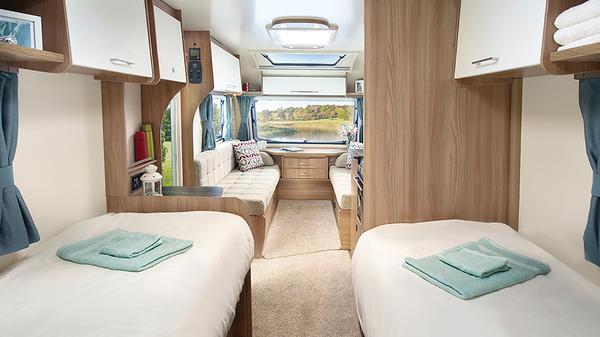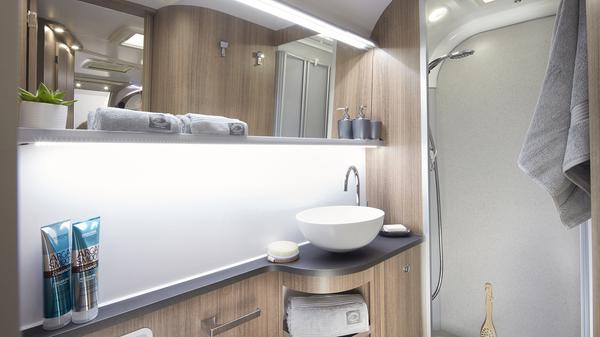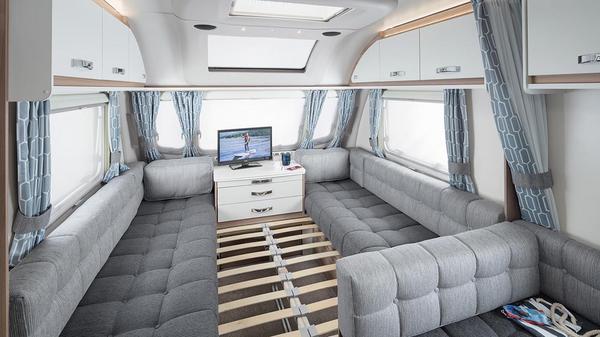Advice
Which caravan layout is best for me?
With experience, most caravan buyers are often looking for a specific layout and know what they do and don't want, but with so many choices, how do you decide which layout is best?

Personal preferences
Ultimately, it is all down to personal preferences and how you are going to be using the caravan, plus the size of caravan your car can tow. Sometimes, you may need think you know the best layout for you, but change your mind after using it for a while, or if your needs change.
For most people, the choice of layout usually revolves around beds (quantity, type and location in the interior), the washroom (location and size) and the kitchen (location and size); then consider what level of specification for interior fittings you want.
For most people, the choice of layout usually revolves around beds (quantity, type and location in the interior), the washroom (location and size) and the kitchen (location and size); then consider what level of specification for interior fittings you want.

Practical considerations
There are many variations of these layouts available in caravans of all sizes, so you will, of course, need to know the maximum weight your car can tow (see our caravan buyer's guide for more details). And if you're storing your caravan at home, or planning to park it on your drive, make sure you know the maximum size that will fit.
Then, looking at layouts more closely, other practical considerations that experience can bring are which side of the caravan is the kitchen or washroom? Many people prefer kitchens or washroom toilets located on the offside so it is easier to connect waste outlets, and so the access door for emptying the toilet cassette is not on the same side as the awning. Where are the heaviest items, like kitchens, wardrobes (when loaded), battery boxes and heaters positioned in the layout? Ideally, for optimum stability, the heaviest items should be as close to the axle as possible. Do you want to shower in the caravan, or do you prefer to stay on campsites with facilities to use instead? In case you are confused and need any help deciding on which layout is best, let's take a look at some of the most popular layouts.
Then, looking at layouts more closely, other practical considerations that experience can bring are which side of the caravan is the kitchen or washroom? Many people prefer kitchens or washroom toilets located on the offside so it is easier to connect waste outlets, and so the access door for emptying the toilet cassette is not on the same side as the awning. Where are the heaviest items, like kitchens, wardrobes (when loaded), battery boxes and heaters positioned in the layout? Ideally, for optimum stability, the heaviest items should be as close to the axle as possible. Do you want to shower in the caravan, or do you prefer to stay on campsites with facilities to use instead? In case you are confused and need any help deciding on which layout is best, let's take a look at some of the most popular layouts.
Kitchens
The usual choice here will be end or centre kitchen layouts.
The majority of modern layouts have the kitchen in the middle of the caravan (as for optimum towing stability, this is the most sensible position for heavier items). The other option is an end kitchen, more usually found in smaller caravans with two-berths (beds). End kitchen layouts are less popular these days since the introduction of end washrooms. It is unusual to have a kitchen at the front of a caravan, as it will inevitably add extra 'noseweight', but this type of layout has been produced, and is still available.
The majority of modern layouts have the kitchen in the middle of the caravan (as for optimum towing stability, this is the most sensible position for heavier items). The other option is an end kitchen, more usually found in smaller caravans with two-berths (beds). End kitchen layouts are less popular these days since the introduction of end washrooms. It is unusual to have a kitchen at the front of a caravan, as it will inevitably add extra 'noseweight', but this type of layout has been produced, and is still available.
Bathrooms
Apart from some of the smallest caravans without enough room for their own facilities, you'll usually always find a washroom at the end, the rear corner or in the centre of the caravan's layout. It would be much rarer to find a washroom in the front corner, but this layout has been produced.
End washrooms are probably one of the most popular layouts and always feature a separate shower. Being located at the end of the caravan offers greater privacy and usually with more space for a shower and changing area. Sometimes the wardrobe is also located in the end washroom. A corner washroom, usually in a rear corner, may also have a separate shower in it. This layout is usually found alongside a fixed double bed. These days, there's two types of centre washroom layouts available. It will either be situated on one side of the caravan (not always with a separate shower), or the washroom could be across the centre of the caravan with the toilet on one side and the shower on the other with, access through the washroom to a bedroom at the rear.
End washrooms are probably one of the most popular layouts and always feature a separate shower. Being located at the end of the caravan offers greater privacy and usually with more space for a shower and changing area. Sometimes the wardrobe is also located in the end washroom. A corner washroom, usually in a rear corner, may also have a separate shower in it. This layout is usually found alongside a fixed double bed. These days, there's two types of centre washroom layouts available. It will either be situated on one side of the caravan (not always with a separate shower), or the washroom could be across the centre of the caravan with the toilet on one side and the shower on the other with, access through the washroom to a bedroom at the rear.

Beds
Caravans usually offer a minimum of two berths and a maximum of six, and over the years manufacturers have tried a variety of layouts for these.
The usual choice of layouts here is whether to have a fixed bed or not. Some feel a layout with permanent ('fixed') bed is an essential luxury, while others think it takes up too much living space and are happy to convert the front lounge ('dinette') in to a bed each time instead. There are a choice of fixed double bed layouts. The most popular has been a double bed fitted to one side of the caravan (called a French bed) with a corner slightly cut off to allow access to the washroom (an end or rear corner washroom); more recently, you can get fixed double beds fitted transversely (across) the caravan (to make it easier for both occupants to get out without disturbing the other); and fixed beds (double or singles) can also be found against the rear wall of the caravan positioned lengthways (with a centre washroom across the middle of the caravan). Fixed twin, single beds are also a very popular layout, either for couples or children who don't want bunks. Most of the time, this layout will come with an end washroom, but this layout is now available with a centre washroom. Some front dinettes have seats that are long enough to use as single beds, but this wouldn't really be classed as fixed single beds. For families, fixed bunk bed layouts have become more and more popular. These are always at the end of the caravan, usually on one side or possibly across the rear, or just ahead of an end washroom. They offer the advantage of children having a permanent bed to use at any time, either for a daytime sleep or somewhere to relax and leave their own stuff.
The usual choice of layouts here is whether to have a fixed bed or not. Some feel a layout with permanent ('fixed') bed is an essential luxury, while others think it takes up too much living space and are happy to convert the front lounge ('dinette') in to a bed each time instead. There are a choice of fixed double bed layouts. The most popular has been a double bed fitted to one side of the caravan (called a French bed) with a corner slightly cut off to allow access to the washroom (an end or rear corner washroom); more recently, you can get fixed double beds fitted transversely (across) the caravan (to make it easier for both occupants to get out without disturbing the other); and fixed beds (double or singles) can also be found against the rear wall of the caravan positioned lengthways (with a centre washroom across the middle of the caravan). Fixed twin, single beds are also a very popular layout, either for couples or children who don't want bunks. Most of the time, this layout will come with an end washroom, but this layout is now available with a centre washroom. Some front dinettes have seats that are long enough to use as single beds, but this wouldn't really be classed as fixed single beds. For families, fixed bunk bed layouts have become more and more popular. These are always at the end of the caravan, usually on one side or possibly across the rear, or just ahead of an end washroom. They offer the advantage of children having a permanent bed to use at any time, either for a daytime sleep or somewhere to relax and leave their own stuff.

Dinettes
If a caravan layout has two dinettes (or seating areas), the second dinette will either be a small side dinette in the middle of the caravan (usually opposite a centre kitchen), or a large dinette at the rear.
The layout with a large rear dinette was, for obvious reasons, traditionally called a 'double dinette', often with a folding bunk to make it a five-berth, or fold-up bunks on both sides as a six-berth. These days, it seems popular to have one side of the rear dinette with fixed bunks and the other side as a two or three-seater dinette. This would still be classified as having two dinettes. As previously mentioned, front dinettes usually convert in to a double bed, or may be large enough to be used as two singles. Most front dinettes have two seats either side of a front chest/cupboard unit. Some don't have the chest unit and have seating cushions there instead to make a u-shaped dinette. The alternative is an L-shaped front dinette. This creates a more domestic-style lounge area and still converts in to a double bed.
The layout with a large rear dinette was, for obvious reasons, traditionally called a 'double dinette', often with a folding bunk to make it a five-berth, or fold-up bunks on both sides as a six-berth. These days, it seems popular to have one side of the rear dinette with fixed bunks and the other side as a two or three-seater dinette. This would still be classified as having two dinettes. As previously mentioned, front dinettes usually convert in to a double bed, or may be large enough to be used as two singles. Most front dinettes have two seats either side of a front chest/cupboard unit. Some don't have the chest unit and have seating cushions there instead to make a u-shaped dinette. The alternative is an L-shaped front dinette. This creates a more domestic-style lounge area and still converts in to a double bed.
Find your perfect caravan